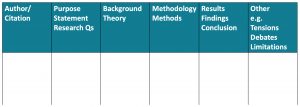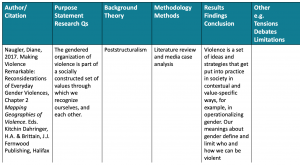6.2 Discussion
Despite articulated course-level learning outcomes (LOs) in the course syllabi, the connection between course LOs, teaching and learning activities, and assessment—or what is commonly referred to as Constructive Alignment (Biggs 1996; Fink 2003) or the Course Design Model (Ellis 2007) (Figure 1 below)—is often not explicitly understood and students may not appreciate why they are being asked to participate in certain activities and/or why or how they are being assessed and as a result how they might improve.

As an instructor, I was looking for a way to increase the visibility of this alignment for students. The ICE framework offers this visibility. The ICE Rubric (Figure 2 below) illustrates for students some of the connections between course learning outcomes (e.g., Communication and Critical Thinking) and how these skills will be practiced and assessed in this course. The ICE rubric helps students to recognize that they will be asked to demonstrate foundational communication skills, such as (a) being able to locate an author’s argument from a particular academic article (i.e., an Idea), (b) more advanced skills (e.g., Critical Thinking), such as finding examples of the relationship among academic articles on a similar topic (i.e,. a Connection), and (c) being able to apply or extrapolate content from one or more of our course readings paper(s) to other contemporary events (i.e. an Extension).

I use the ICE framework (Figure 1 above) in combination with the Academic Reading Review Table (Figure 3 below). The reading review table helps develop students’ ability to carefully read and document the specific kind of Ideas to which the course learning outcomes refer.

ICE as a Conceptual Framework
To make the “big picture” of the course more visible, I include the ICE language explicitly in the course learning outcomes associated with “Communication” and “Critical Thinking”.
Communication: Communicate a sociological imagination via ideas, connections, and extensions (ICE) effectively orally and in writing.
Critical Thinking: Analyze the connection between the way women as victims, offenders, and professionals are defined, measured, theorized, represented, and responded to by media, research, policy, and the criminal justice system.
I modelled the development from Ideas to Connections to Extensions through a think-aloud process that encouraged students to take notice of the qualities and characteristics of each frame of learning. Based on my own experience and observations of intentionally using ICE as part of the design of the course and based on solicited student feedback and reflection, I found that using the ICE framework increased student engagement and participation, especially in discussions and classroom activities. Let’s take a closer look at some examples from my Violence and Society course to illustrate how I use ICE as a conceptual framework, a formative teaching, and learning activity, and as summative assessment.
ICE as Formative Activity: Reading an Academic Article
One of the primary teaching and learning activities used in the course is working on how to carefully read an academic article. Individually and weekly my students use the ICE framework as a way to practice close and critical reading of academic literature by (a) identifying the essential Ideas from individual academic journal articles, and (b) exploring Connections across multiple forms of literature.
As a post-secondary educator, despite some of the challenges of time and process, formative assessments are a feature of my pedagogical approach that I find have value and helps students move forward (Chanpet, Chomsuwan & Murphy 2020) in developing the knowledge and skills that will be more formally assessed in the future. In order to help students grasp what is expected when they read these academic articles, I use the Academic Reading Review Chart (Figure 4 below)[1]as discussed above to help ensure students identify the most important content (Ideas) from each article. As a formative activity, I ask students to form small groups in class and talk about the Ideas they extracted from this article and from the other articles that were assigned for that week. After the small group discussion, we turn this into a large group activity and I ask for volunteers to identify the Ideas by marking the letter I in their readings and identifying Connections by marking the letter C. We go through each column of the chart to provide students with practice, in a low-stakes environment, identifying the Ideas component of the ICE framework. Once the relevant Ideas have been identified, we use the same process for identifying Connections across multiple articles for each week of readings.

ICE as Summative Assessment: Critical Media Assignment
Connected to the teaching and learning activity above, I use the ICE framework to inform the design of assessments to grade students’ individual and group work on their ability to communicate and think critically (and sociologically). One of the assignments used to practice Ideas, Connections, and Extensions is called a Critical Media & Topic Analysis (Figure 5 below for a brief overview of the assignment). Students sign up for one of the optional topics they are interested in and self-select into small peer groups. Students are assigned academic articles that report on the way violence is typically depicted in the news. Asking students to reflect on the way that sexual violence for example is depicted in a newspaper article is a great way for students to demonstrate critical thinking.

Once the student groups are formed, students collectively choose a current mainstream media source (e.g., a newspaper article, TV show, documentary, song, etc.) that portrays their topic. As identified in Figure 5, there are three parts to this assignment: (a) an individual one-page proposal, (b) an oral small group presentation and, (c) an individual short written analysis. All parts of the assignment ask students to provide specific evidence in answering the following questions:
To what extent does the media source (e.g. newspaper’s depiction of sexual violence) affirm or contradict the:
- research on sexual violence from the academic articles?
- research on the way media typically portrays sexual violence?
In answering these two questions, students must demonstrate their ability to find and provide evidence for relevant Ideas, Connections, and Extensions. As outlined above as a formative activity, students must start this assignment by identifying the Ideas from each of the topics (e.g., sexual violence) and media research articles on portrayals of sexual violence. In other words, students need to have read all of the assigned academic articles and understood these specific Ideas from each article:
- the purpose of the article and/or the research questions that guided the study.
- the theoretical perspective used in the paper
- the methodology/methods used (i.e., a literature review or if the article reports on a study, how was the data collected/analyzed,
- the findings/conclusions of the author and
- any tensions/debates identified in the literature by the author
Once the Ideas of each paper have been addressed, then students are asked to identify the Connections across the academic articles on sexual violence and the Connections across the media research articles on sexual violence. During this phase, and in keeping with the course learning outcomes, students draw attention to and analyze Connections at the content level and articulate the relationship between or among the papers’ findings/conclusions (for example are they aligned or not?). Students consider whether there are Connections to be made across the academic articles on sexual violence and across the media research on sexual violence. Finally, students are asked to demonstrate their Extension skills by (a) taking the Ideas and the Connections from both sets of literature, and (b) evaluating whether they see any of these Ideas and Connections showing up in the way the current newspaper clip they chose portrays the issue. The purpose of the assignment is to think about whether the causes of an issue like sexual violence are explained in a similar or different manner compared to how it is depicted in mainstream news (like a newspaper).
In class, I provide a couple of examples for each stage of the ICE framework. As an Extensions example, I played an episode of Full Frontal with Samantha Bee, which is an American TV late-night talk show and news satire program. In this episode titled #MeToo Backlash Samantha Bee discusses sexual harassment and the #MeToo movement. Before showing the clip I ask students to watch the clip and try to find evidence of the way in which sexual violence is explained and theorized. After the clip is played, I project the following slide as an example of a relevant and appropriate Extension for the purpose of the media assignment and in keeping with the Communication and Critical Thinking course LOs.

Specifically, the slide is intended to show that a sociological explanation for sexual violence is offered from both the academic research (in this case Nagler 2017 and Walby, Towers & Francis 2014) and Samantha Bee’s commentary. In this example, there is a Connection between Samantha Bee’s explanation of sexual violence and the theoretical perspective of the academic articles on gendered violence. In some cases, the explanation between the media source and the academic literature on a topic may not be similar, and if this is the case, students would be expected to notice and articulate the lack of Connection or the dissimilar theoretical perspectives offered. Either way, the same set of cognitive skills are being assessed.
- . Figure 4 is a completed chart and is an actual example of the kind of Ideas that students would be expected to extract from one of the actual articles used in the Violence and Society class on the topic of Gendered Violence. ↵

